

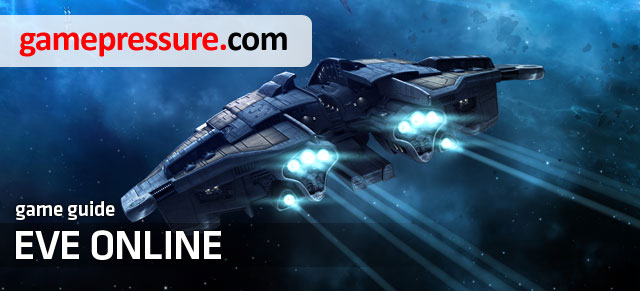
This guide is dedicated for people who just began playing in EVE Online Players who play more than several weeks will probably know most of things included in it. But the player, who is freshly after the basic training missions, may find here many useful information which allow him to find his own unique playstyle. As each player in EVE. What would you do if after several orders from your trainer, you'll get an order to fly out from the Academy and live on your own? When EVE Online was a younger game, you had less possibilities. As of the time being, after several dozens of expansions, the game's universe has became deeper, wider, more dangerous and interesting and that's why more unavailable for new players. EVE Online as a space simulator offers many paths for your character: from a noble man, through the space merchant to the explorer of new systems, mercenary and defender of the poor or a leader of the pirate fleet and a thief. Hundreds of constellations, thousands of systems, millions of enemies, billions of ISK to earn. And lose. Huge battles between player's alliances are the core element of the game and losses reaches tens or hundreds of thousands of dollars. Real, American dollars. If you want to grab at least 0,1% of this, immerse into the game which is visited daily by more than 50,000 players on one server.
In the guide to EVE Online you find:
Dawid "Kthaara" Zgud ()
This guide is dedicated for persons who just began playing in EVE Online Players who play more than several weeks will probably know most of things included in it. But the player, who is freshly after the basic training missions, may find here many useful information which allow him to find his own unique playstyle. As each player in EVE.
This guide is written basing on my main account, on which I can show all game aspects with details. But some elements are shown from the new Trial Account to present them to players who begin their adventure with EVE.
When I write those words (February 2014) EVE Online is active for more than ten years, and the current expansion is the twentieth one, Rubicon. I write this because mechanisms described in here may vary a bit due to the adding new expansions to Tranquility, what happens about once a half a year.
EVE Online is unavailable every day at 11:00 UTC for about 15 minutes for a quick connection and server diagnostics and adding small patches. Usually bigger patches and expansions cause longer pauses, but when it is to take more than half an hour it's announced earlier.
The game itself requires paying a monthly subscription in various forms: directly for the producer, in form of codes and CD-keys or with PLEX, special in-game items you can buy also with virtual current.
Black - all important elements which are not included in the categories below. Like NPC corporations, space points, missions ordered by NPCs and game hints.
Brown - Items: Weapon, ammo, ship equipment, plans, materials. Most of things you can buy in the game market.
Orange - Skills. The most important element: knowledge. And books you have to read.
Blue - Interface elements. It may be a bit overwhelming.
Green - Ships. There is a lot of types and they may be really huge.
Legend doesn't cover picture numbers. Color there corresponds with the color of frame and number on the picture.
During this process you'll create a unique hero for you to play each time you launch this game. Prepare your character very well, to be able to identify with it. From that moment, even during the voice chats or using Skype and other communicating tools, you'll be known as Mr/Ms X, as it happens usually in MMO games.
There are five living and several extinct races. Four of them are playable. Among those four races, each has three variations. Your character can also be from three different environments and study on three different universities.

Choice of the race doesn't influence the game too much, in only varies the set of skill you have at the beginning. Each player may develop in a random way, so a man from the race specialized in drones, may become a cannon expert.
Amarr Empire - the biggest in-game empire. Huge and vast theocracy, where Empress is the superior power and people can sacrifice a lot for her. It's the only one society which openly have slaves.
It's allied with Caldari. Amarr ships uses usually Armor as a main defensive tool and Energetic Cannons as a main offensive tool.
Caldari State - oligarchy and assembly of mega-corporations. A wet dream of capitalist. Caldarians split from Gallente because of argument between the government and corporations. Area with huge fortunes but also with poor masses. They have the main in-game trade hub, Jita.
Amar's ally. Caldari uses usually Rockets and Energetic Shields.
Gallente Federation - second in-game power. Backbone of democracy, liberalism and freedom. Gallente is a structure with government and president where slavery is despised. They actively support all liberating movements.
They are allied with Minmatar. For attacking they use mostly Hybrid Cannons and Drones. For defensive purposes Armor.
Minmatar Republic - past slaves of Amar. Republic is the youngest and smallest political entity in here. Years of slavery made them tough and rude.
They are allied with Gallente Federation. Their ships uses mostly Standard Cannons and, less often, Rockets. As the only one nation, their ships may use both Armor and Shields.
Each race divides onto three bloodlines. They differ mainly in a visual way and they affect character's description and history a bit.
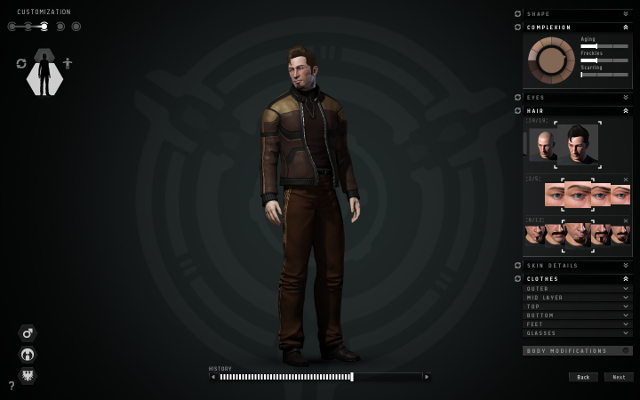
Here you can specify an appearance of your character. Adjust eye and skin color, face, hair, beard and eyebrows. You can also choose among many scars, tattoos and rings. Most of elements may be modified with a mouse button, by clicking on it and dragging it. What is more, you can also choose an outfit for your character.
All changes you make are visible on the bar below. You can return to each of them anytime while creating a character.
Here you choose the portrait, which will be a representation of your character. It's very important, because it'll be your official in-game face. You can change each at anytime on the station with a proper module.
You can make four portraits using several dozens of backgrounds and several poses. Also here you can modify position of head or the face expression.
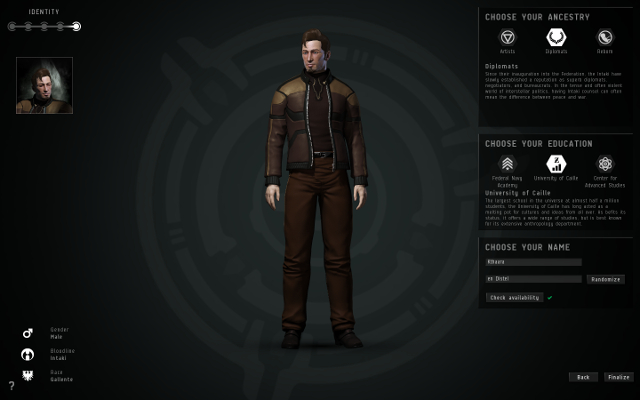
This window checks all previous steps and let you choose two last ones: your origins and education.
Origins serve for enlarging history of your character and doesn't affect the game. Each race has three possible options.
Education has more influence. You can choose one of three: military, economic and scientific. Your choice determines your starting skills. They are, usually, from gunnery, engineering or production. Education defines also your belonging to the first corporation.
Appearance, outfit and portrait may be changed in anytime on the station with Re-customization module. You won't be able to change anything else.
Look through the remaining data, write down your first and second name and click Finalize.
Just after clicking the Finalize button, game loads your cockpit at the main station of your corporation. You can walk there freely, like in other MMOs, using the WSAD. Most of its elements is interactive and leads to different windows of interface. New players will get an explanation after clicking for the first time on the less obvious elements (like Fitting, Corporation Management or Agent Finder).
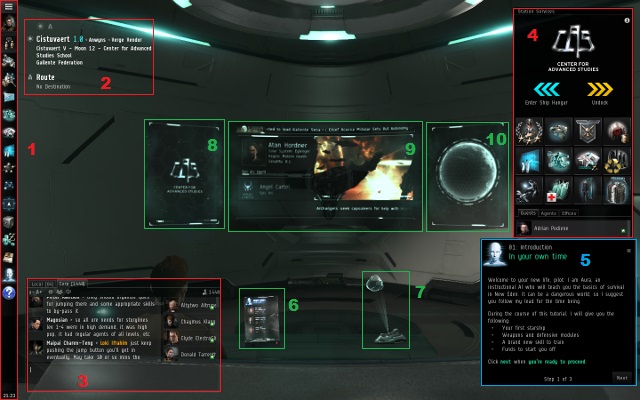
Always available elements:
1 - NEOCOM. Bar containing all basic interface icons. You can modify it freely, add and remove icons besides the few most basic. You can also decrease and increase it, lock it or hide it.
2 - Basic information about your position and in-system events. You can turn it on and off with icons over the bar, like also roll and unroll. You have here information about: system (star), route (letter "A"), planet (planet icon), ISIS system (spaceship), incursion (skull), and missions from agents (man in a hat). Additionally, you can change elements options of the bar by clicking on the bigger icons on left.
3 - Chats. In tabs you can find various chats of your character. Always visible are Local and Corp and also Incursion, but only if you're in the system affected with it. Chat window, as the majority of in-game windows, may be minimalized or made transparent with two buttons in the right corner.
4 - Station window. Available only while docked at the station. You can find here information about the station's owner, services and also list of agents, guests (docked players) and offices of corporation in here.
Tutorial - only new players:
5 - When you're a new players, the tutorial window appears. Aura will explain to you many basic elements of the game like: chat using, agents finding, moving around the station and space, completing agent mission, arming ships, managing your goods, gaining new skills and many other, important things. If you're in-game, tutorial is very recommended, because it gives you not only knowledge but also several items and many skillbooks and ships.
Interactive objects inside the cabin on the station.
6 - Agent Finder. It opens the window where you can find agents of different corporations, who may offer you some missions. Missions are an important source of money in this game.
7 - Your ship. When you move cursor over it, you get a list of activities concerning your ship Cargohold, Cargobays, Fitting, Ships and possibility of moving into the hangar. Hangar isn't interactive but for the possibility of look at the ship from each side.
8 - Corporations. Here you can see a logo of your corporation. After clicking on it, a corporation window appears where you can search through the statistics or look at the other corporation.
9 - Information window. Here you can find many interactive information about different aspects of the game, just like on the Billboards at each stargate: about incursion, headhunting, trading option and many others.
10 - Planets. If you have any center of planet control in the particular system, you can manage them after clicking this window. Planets are rare sources of constant in-game income.
When you leave the station, notice that the interface has changed. In the space you have lot of options from the stations, but many others are available only on the station or outside the station.

Interface elements in the space:
1 - Your ship. On this screen you can see a Iteron V - transport ship. It's always in the center, unless you choose option of looking at something else. Camera can be rotated, move away or closer. Notice, that moving away and closer with a mouse wheel works inversely than in other games.
2 - HUD. The most important interface element in the space. It covers several things: health of your ship. It is shown on three bars: shields, armor and structure, modules mounted on the ship are shown on right from HUB (on the screen it is Afterburner) and five icon on left. Those buttons open cargo and scan and launch Tactical View, useful during battles. You can also launch autopilot and display camera options.
3 - Information about the marked object. Here you find information about marked ships, stations, wrecks, gates and natural objects. What is more, you can see a list of actions you can do.
4 - Overview. It shows a list of objects according to the chosen filter. You can also create up to few new tabs after clicking on the Add Tab button.
5 - Objects index. Around the screen you will see various indexes of objects detected by your radar. Those indexes will belong both to the closest players or NPCs like also to the stations and gates.
6 - Information window. Here you will see information about the state of the ship, like incoming, orbiting or warping.
During the Tutorial missions you'll get a ship, several skillbooks and items. You'll destroy your first pirates, go through the stargate and complete several agents' missions.
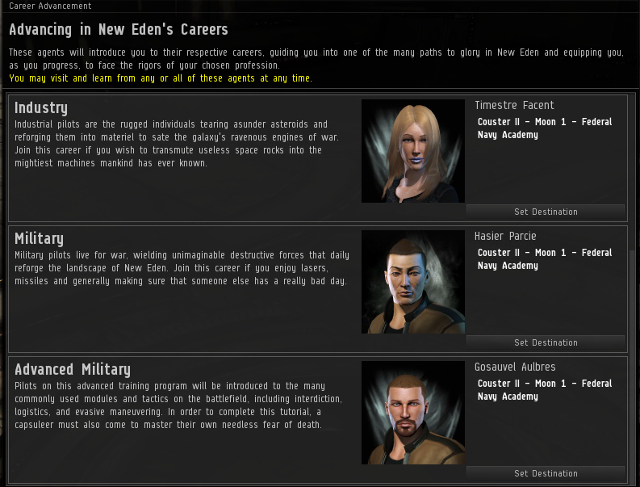
At the end, Aura will leave you in the system with five new agents, so called career agents. Each of them will present you other aspect of the game. It isn't obligatory, but it's good to make all missions as they give you an access to many new skills, items and ships. Completing all missions from this agents takes about 12-16 hours. It should give you a hint about the later progress of the game.
Business and Industry Agents give missions connected with harvesting and processing of the material and production based on items scheme. What is more, they teach you how to buy cheap and sell expensive, but EVE market rarely offers huge occasions. After completing this mission, you get, among others: Venture.
Exploration Agent helps you learn how to use probes to find lost trash in the space and change it into money.
Military and Advanced Agents will show you what is the scheme of Security missions and let you feel the lost of the ship. When you get a mission in which you lose a ship, don't install anything on it! You have to lose the very ship you was granted with. One of rewards for this tutorials, besides items and skillbooks, is a frigate and destroyer.
During those mission, it's very possible that Game Master will write to you. He'll ask about your first impressions, answer on several questions and suggest development of your character. It's a good idea to add him to your contacts. Click on his portrait and on "Add contact" button. You will be able to ask him about anything.
From now on, all the galaxy is open for you. It's vast, full of possibilities with a rich history. But sometimes dark and dangerous. There are many paths to the richness. Your first task is to set a goal for your character. Yes. Only making progress in one chosen way you'll be able to achieve something in a short amount of time.
In most of MMOs, you get experience and levels what determine your position in the game. In EVE, experience is replaced by Skillpoints, and learning a new skill takes particular amount of time. It lasts even when you're out of the game. To not waste time for development (lost of several hours means even several thousands of points less) there is a Training Queue.
It let you schedule order of skills in time no longer than 24 hours. It means that during those 24 hours you can switch skills and everything what is out of this time is just simply out.
Abstract example You have five skills which requires, orderly: 1, 4, 4, 16 hours and 4 days (96 hours). You can queue them like that: 4+4+16 = 24. But the day after tomorrow you'll have to enter the game and add something. What if you don't have an internet? In this case it's better to make a queue like this: 4+16+1+96 = 117 hours. The last skill sticks out the queue and gives you a reasonable time limit if there are any connection problem.
As you can see on the example, learning takes long hours, then days and weeks. You'll get used to the fact that skill learned in four days wasn't that long to learn, when it will take for example a month to learn another one.
Your character has five attributes (available at character's sheet after clicking on your portrait in NEOCOM). Each skill is inscribed to two attributes which influence speed at which you learn it. Each character has a possibility of so called remap (changing allocation of your skills) once a year. New characters have two additional remaps.
Attributes may be increased also with implants. But to use them, you'll have to have a skill of Cybernetics on the proper level. New players may also increase their skills using a Prototype Cerebral Accelerator booster, but the price of 300 millions of ISK may be overwhelming.
Here I will describe several interface elements which you should take notice at. Perhaps Aura already has told about them, but she didn't mention everything. Remaining windows are less important at the beginning.
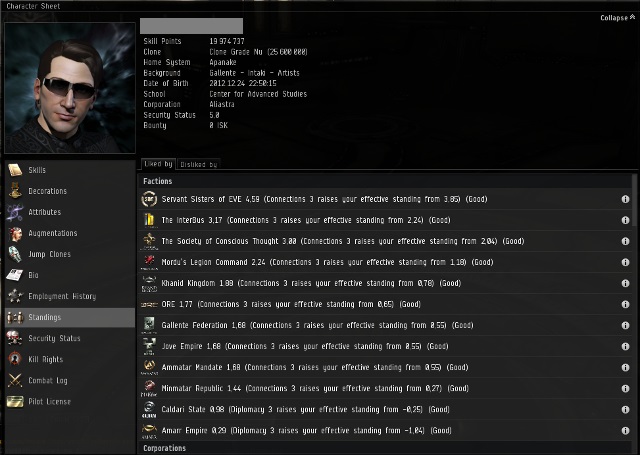
It's available after clicking on the portrait on the NEOCOM bar. Thanks to that you have an access to many information about your character like:
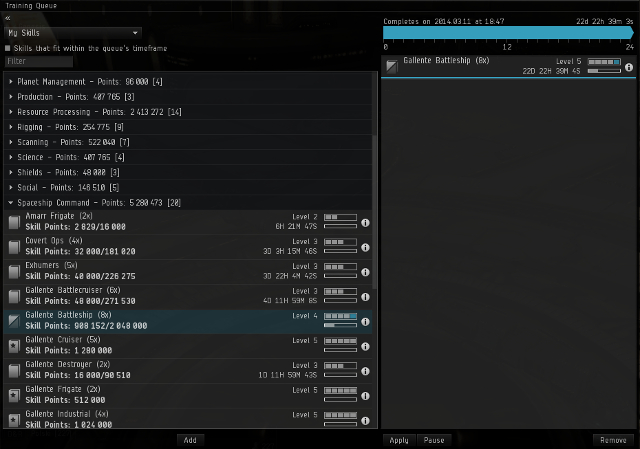
Just under the portrait you can see a small black and blue bar. It's your skill queue. You have to fill it in 100%. Even better if a long-time skill sticks out of it. Remember: time is priceless in this game. Each hour is about 2000 points, so the whole day is about 50000 points which you won't get back.
Each skill in the game appears as a SkillBook which ay be bought at the lowest price in stations-schools. Price varies depending on the importance and skill type. The basic ones cost about tens thousands of ISK, while the most valuable and specialist cost even several millions.
Time of learning depends on the skill level, its rank and your attributes.
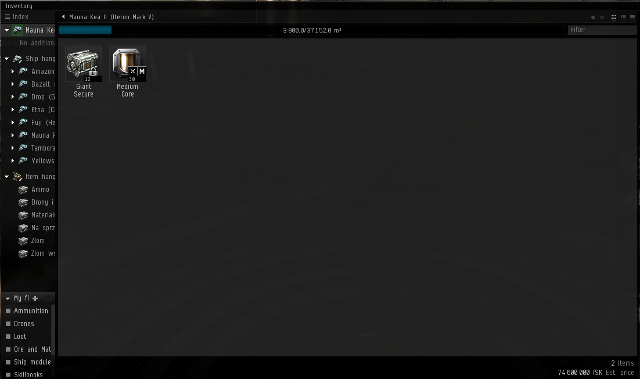
Inventory is place to store your ships and their equipment. In station, the list is divided onto three categories:
Below the list you can see filters to which you can add your own. On the top there is a blue bar showing the level of fullness of the cargo/container. Space of the main hangar in the station is unlimited. In the right bottom corner you can see an item counter and rough value of all/marked items.
Assets show the list of stations on which you have something. It's good to keep this list in reasonable size, unless you have a corporate galactic fleet.
Fitting is one of the most important in-game windows. I'll show it on the example of Strategic Cruiser.
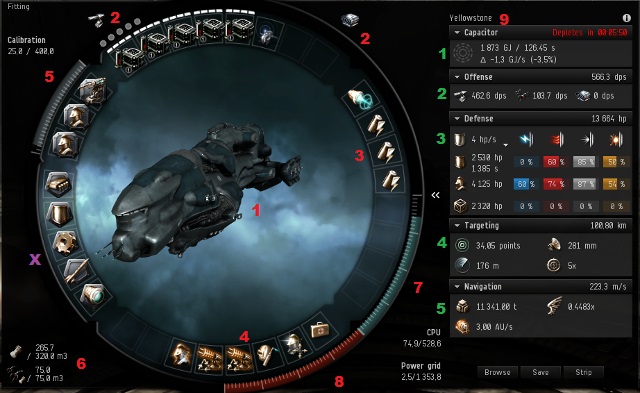
Fitting window has a lot of details, from which is extremely important for your safety and success in space. Never fly out in a ship of which you're not a 100% sure and if you can't buy a similar with the whole equipment. In EVE Online there is a rule - don't fly with something you can't replace.
If you notice during the game that you've made a mistake in arming the ship, warp back immediately unless you're experienced and skilled enough to deal with it.
Number of slots depends on the ship. Usually, Amarr and Gallente have more LOW slots than MEDIUM due to their more armor fits. Caldari and Minmatar have roughly the same amount of MEDIUM and LOW slots because of their energetic shields.
Description of window elements:
1 - general appearance of your ship. You can rotate it, move closer or away.
2 - HIGH POWER slots. In this slots you mount mostly things with huge energy demand like cannons, rocket launchers, repairing sets, energy transmitters, shields and shield disruptors. Over it you can see two icons - cannon and rocket launcher. Below them is a symbol of how many cannons or rocket launchers ship can have. It's important because you may have like 8 High slots and only 6 Hard slots.
1 - MEDIUM POWER slots. Those slots are the most important for ships where their main defense tool are energetic shields, because majority of them uses those slots. What is more, those slots are also used for modules like Afterburners or Microwarp Drives and modules improving charging the ship battery.
4 - LOW POWER slots. Number of those slots determines fitting the ship as an "armor tank". Most of improving armor modules cover those slots. What is more, they are used to augment the battle power by mounting here increasing damage modules or such adding attributes, like processor/reactor power.
5 - Rigs. Rigs are permanent ships' modifications. Each of them takes some calibration points, so you have to remember about it. What is more, each rig has some negative effect on other ship's aspect. When you want to pack ship with Rigs the game will ask if you're sure, because Rigs will be destroyed. Number of those slots depends on the technology level of the ship. Most of ship with T1 level have three Rigs slots and 400 hundred calibration points. T2 have 2 slots and 350 calibration points, T3 (Strategic Cruisers) have three 3 slots and 400 points. While Frigates have no slots. To use Rigs you have to have Jury Rigging skill on 3rd level and then train a skill for the modification, like Armor Rigging or Hybrid Weapon Rigging. Each rig has four variations: small, medium, large and capital. It depends on the ship's size.
6 - Fullness of cargo and drone cargo.
7 - CPU Counter. Each ship makes particular number of teraflops, thanks to which you can control all of it. Each module takes a bit of that. To make all modules work, their summarized CPU can't be bigger than the maximum CPU of the ship. Skill CPU Management modules Co-processor and rigs Processor Overclocking Unit increase the amount of CPU produced.
8 - Power Grid (PG). Each module uses a bit of ship's energy. As in the case of CPU, sum of all modules' PG can't be bigger than the available power. Otherwise some components won't work. Skill Power Grid Management, modules Auxiliary Power Control and Reactor Control Unit and also a rig Ancillary Current Router can increase the maximum power.
9 - Ship's name Dragging it into the chat will copy the link to current fit of the ship you see. Very useful while discussing fits with friends or corporation.
1 - Capacitor. Each ship has a particular amount of gathered energy. It's used for the work of all active modules like cannons, shield regenerators and armors, accelerators. In the statistics you can see an information about: the size of battery (it may be increased with modules, rigs and skills), time of regeneration (also can be modified likewise) and information about so called stability, which is amount of energy produced and used while all modules working. On the upper tab you can see a time after which battery discharges. In general, during PvE missions you want to have the longest possible time or Stable. On PvP missions everything depends on the type of fight.
2 - Offensive. Damage dealt is divided onto three categories: cannons, drones, rockets. Each of them may cause four different types of damage: Electromagnetic, Thermal, Kinetic and Explosive. On the bar you can see total DPS from all of them. The bigger, the better. Damage may be increased with particular skills from Gunnery, Drones and Missiles section. What is more, each type has its own modules of range and damage.
3 - Defensive. Ship has three HP bars: shield, armor and structure. Shield regenerates itself very slowly. Armor requires particular modules for regeneration. Structure also has proper modules for repairing, but it's the durability of your ship's hull. It shouldn't be touched! Usually one-two shots at the structure destroys the ship. Each bar has resistance against four types of damage: Electromagnetic, Thermal, Kinetic and Explosive. When you make PvE mission you fit usually for two types of damage dealt by enemy ships. HP of particular bar depends on skills, modules and ship's modifications. Also resistances depend on skills, modules and rigs. On the bar you can see also EHP (Effective Hitpoints) indicator. It shows how many damage ship may take before getting them reduced.
4 - Targeting. Each player has to target the goal before he can attack. Amount of available targets depends on the Targeting skill and ship's electronic. Range o targeting depends on Long Range Targeting skill and some modules. Additionally, you have to remember about the targeting speed. The bigger ship, the easier it's to target it. But when you fly a big ship, aiming at the small and agile frigates is a torture. On the bar you can see the range of targeting.
5 - Navigation. Here you see a ship's mass, it's warp speed and several other information. On the bar you also see a speed in meters per second.
X - Slots for Subsystems - only Strategic Cruiser has this kind of slots, thanks to which its statistics may be modified.
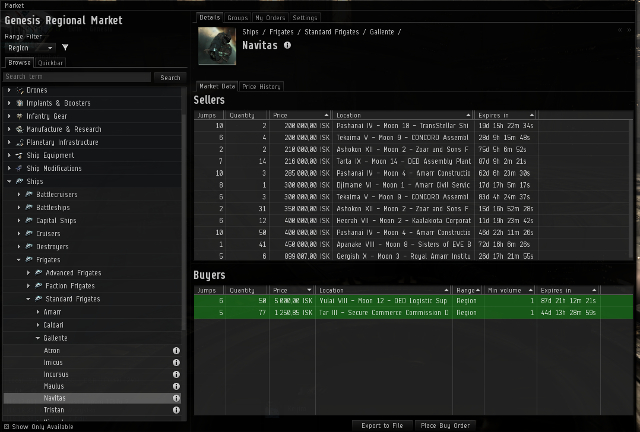
Market in EVE is something unique among all MMO games. It's driven by the rules of supply and demand and almost everything on the marker was produced by players. Producers provide only two things: Blueprints which are the plans of most of the items and Skillbooks.
The whole rest, which is ammo, drones, ships, equipment, implants, rigs and others are mostly produced and gained in various ways (like missions or LP points) by players.
Market has a maximum range of one region, but in the Internet you can find several pages with the whole market of EVE Online.
The most important trade hubs in EVE:
Jita (The Forge, Caldari State, about 2000 people) - the biggest in-game hub. You can buy here everything at the lowest price and sell everything but not necessarily at the highest price.
Dodixie (Sinq Laison, Gallente Federation, about 450 people) - the biggest Gallente's hub, 15 High Security system jumps from Jita.
Amarr (Genesis, Amarr Empire, about 400 people) - big hub in Amarr, 9 HS jumps from Jita.
Rens (Heimatar, Mintamar Republic, about 400 people) - big hub in Mintamar, 25 HS jumps from Jita.
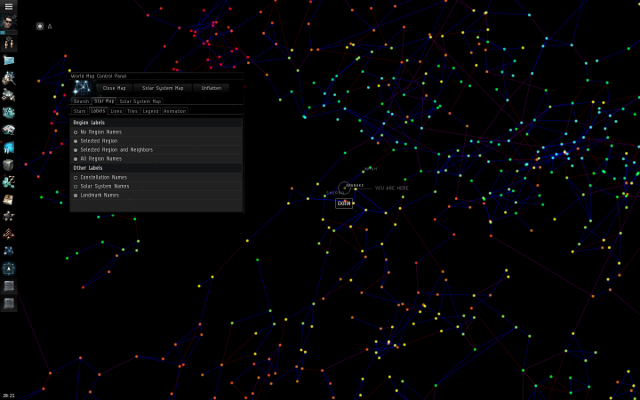
Map in EVE is used mostly for planning single flight. For big allies who have power over Null Security systems, it becomes a battle map. From time to time there is a big battle with hundreds of players in some calm system.
Map may be set due to your own taste, so it can both shows information useful for getting money (number and type of planets, number of stations, asteroid belts) and surviving (number of shot ships, destroyed capsules, owners of Null systems).
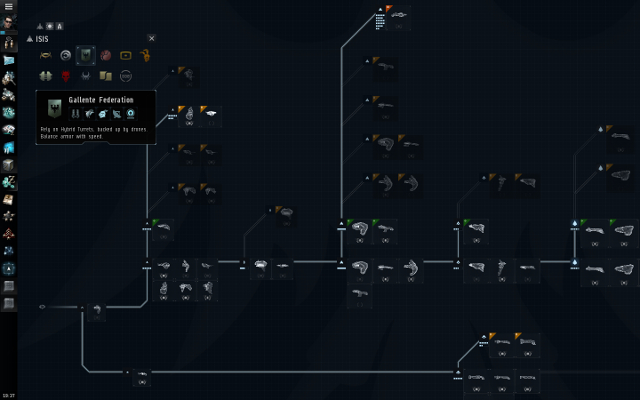
ISIS (InterBus Identification System) shows the particular race's ship tree with skills required to pilot them and Certificates, which are sets of skills which you can get to improve performance of the ship. Some of them are useful only with certain playstyles.
ISIS shows ships and required skills in a tree form. Usually, you need to get particular skill at level 1 to be able to pilot given ship. But in that case, you may be able to fly with the hull only. Equipping it is the whole other story and long days and weeks of getting proper skills.
T1 ships are shown horizontally. T2 ships are shown over the T1 ships. They are much more specialized and used for a particular in-battle function, like repairing or scouting. To each class of T2 ships you have usually a special skill. T2 has two sets of bonuses: one for the basic skill and the other one for the special skill.
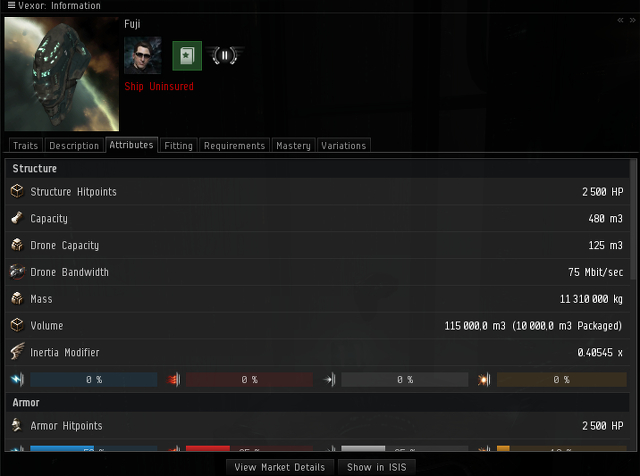
Information Window is important because it shows you various information depending on the object you click on and choose Show Info option. Each item, if available on the market, is linked.
For ship you'll see a window in which you can check everything about it. Those information are bonuses, description, attributes (like HP, mass, resistances, additional cargos, speed etc), number of slots, CPU, PG, required skills, certificates and alternative version if they are any.
For characters you will see Bio, race description, medals, service and relations with you, your corporation and faction.
For module you see a window with description, attributes, requirements and possible version which also can be compared.
The goal of this game is fun. But to do small steps for that, you have to have virtual current. In EVE, it's InterStellar Kredit (ISK; the same ISO is reserved for Icelandic krona). Earning it is very difficult at the beginning, and later on it isn't much easier.
When in the most MMOs you can feel proud for your 1 gold or 100 gold, in EVE you make a big step when you obtain 10.000.000 ISK (ten millions). Truth to be said, it's not much even for the beginner, because you won't buy and equip with it even a cheap cruiser. Next big steps to the wealth are about 150 m ISK (worth one BS), about 600 m (one PLEX) and then 1 billion.
It's about the only virtual currency from the game which can be half-officially transferred onto dollars and other real currencies. The conversion rate moves between 10 to 20 dollars for month of playing, depending on the how you pay for the subscription.
Fits presented in this text are just examples. All depends on your factions and the direction you take with your character.
On road to wealth you can distinguish several alternatives:
If you begin the game alone, you'll probably won't get into this kind of earning money. But if you get an invitation from a friend, ask him if he doesn't need help in basic things, like collecting wrecks after missions.
It may seem to be inappropriate or not ambitious, but at the beginning all money plays and, sticking to the wreck searching, it gives mutual benefits. If your friend/dude met in-game makes mission in a ship which is not proper for collecting wrecks (read: not Marauder), he'll have to fly after the missions ends and collect things, what takes time. And time is money. If you offer him your help, he'll be able to make missions faster, what means earning money faster. And you get an honest (or not) percent for that.
Mining we can call a group of activities which lead to selling the gathered ore or minerals you get from them.
For the beginner, mining may be one of the most stable income source. What is more, you don't have any special skills for that, as you can train the basics within several hours.
At the start, the only right choice to make extraction is Venture. It's a ship to extract in difficult conditions with ore cargo for 5000 m3. It has bonuses for extracting ore and gas, but you won't be interested in gas for a long time, as it requires advanced skills.

In the fit above, Venture has installed modules as following (with required skills):
The total time of learning for the ship and fit for this set is about 21 hours for characters without any skills from those above what is unlikely to happen. If you want to save time, you can give up Salvager what gives you 11 hours of earned time.
When it comes to price...it will differ greatly depending on where you are. As in life, you get for the bigger shopping to the mall, in EVE it's worth to look for some trade hub. The best is Jita, where you can save even several millions of ISK. Not on this fit of course, but it's always worth a shot, because in the beginning systems prices are higher due to the demand generated by the new players.
Price of this set (with necessary Skillbooks) in Jita is between 2 millions for fits with meta3 modules up to almost 3 millions with meta4. You can cut expenses for about a million, if you resign from Salvager.
Spending small money you can easily make a machine which will provide you with two-three millions an hour. In the meantime you can e.g. read a book.
When you have a fitted ship, search nearby the system with 0,5 security status where you can find a lot of asteroid belts. Then, make one of system stations your base and sell ore to the local traders.
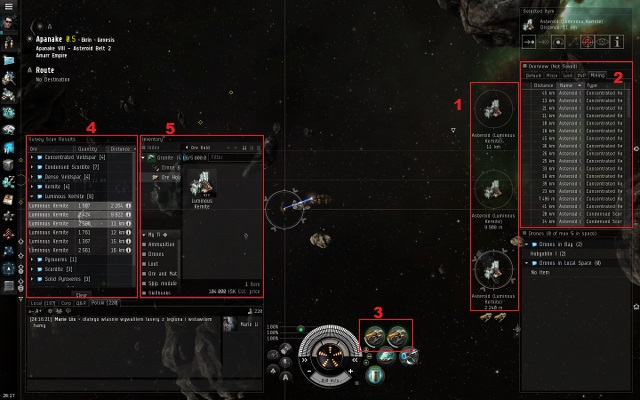
On the screen above you can see several elements which may be useful while ore extracting.
1 - Locked targets. Keep here only asteroids you want to dig through and keep them close enough.
2 - Overview. Make a new tab (RMB on the existing one -> Add Tab) and set its filter on Mining. You'll see only asteroids.
3 - status of mining lasers. Green light and white borders mean that lasers are working. Stopping the cycle will give less ore.
4 - window of Survey Scanner. Lists all rocks in range, displays ore and its type and quantity. You can mark and lock targets from this window clicking on them with Ctrl pushed.
5 - Cargo view. It's sometimes worth to look here and notice when it's full. Venture can't expand its cargo but there are more advanced mining ships (Mining Barges: Retriever and Mackinaw), which cargo depends on the skill level.
For the better income, some players make minerals from ore and sell minerals not ore. But new players don't have proper skills and relations with NPC corporations to convert ore cheaply. So the better choice is to simply sell ore.
You can convert ore without losses and for free. You need several skills for that: Refining 5, Refinery Efficiency 5, skills responsible for converting the ore (like Veldspar Processing) at least at level 1. To not pay the tax (which normally is 5% and is paid in converted materials, not money) you have to have relations with the owner at least at 6,3-6,7, what is very high for the beginning.
If you want to play a little more actively, you should be interested in missions ordered by NPC agents. Completing missions is much more exciting and provides you higher variety of action at the beginning.
Completing mission won't give you a lot of money at the start, but it's worth to complete first level mission for Standing and unlocking an access to better missions.
If you stay faithful with one corporation, you'll get more ISK for missions and LP points for which you can buy precious items and allow you to make important missions which will increase your faction Standing.
When you begin first level missions, give up on frigates and train yourself to pilot a destroyer of your faction. Each race has two types of destroyers, each of which has a little different playstyle. Gallente for example has Catalyst and Algos. Catalyst is a straight battleship with up to eight cannons and bonus to their range and locking speed. While Algos is more distant attacker. It's equipped mostly in big Drone Bay from which its main strength comes.
To the second level mission you should have at least a cruiser, because you may meet enemies in such ships.

On the screen above you see Vexor cruiser which is perfect to handle all first and second level missions and some third level too. This ship is rather quick, very mobile and serves players well with its versatility. As your skills will grow, the easier it becomes to control the battlefield chaos and destroy enemies.
This Vexor has modules (with appropriate skills given) as following:
To ship with such an equipment, you'll need, depending on your faction, from two to three days of training. The price with skills is about 13 to 16 millions of ISK. It differs depending on where you buy. The cheapest way is to choose a trade hub, the best is Jita.
Playing as a destroyer, you should remember that it has less MEDIUM and LOW POWER slots. Module Damage Control is worth investing in. About the rest: focus on the advantages and bonuses of the ship and use them to the maximum. If ship has a bonus to cannon/rocket range, mount cannons and rockets. When ship has drone damage increased, try to get as biggest DPS with them as you can.
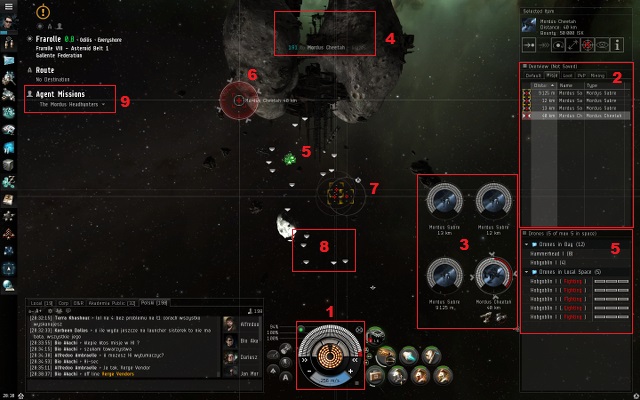
On the screen above you see elements of the mission window:
1 - HUD. Monitor health bars on it. Each of them has a threshold overcoming which will alarm you with a signal. Thresholds may be set in options. Click on the small square with lines on right side of HUD.
2 - Overview. It's a good idea to create a new tab and filter for missions (showing only mission targets). Nothing will distract you in this case.
3 - Locked Targets. The bigger level of Targeting the more you can mark. What is more, you can see the damage of enemy ships and your attacking tools.
4 - Information window. Here you can see how many damage you deal to enemies (blue) and how much you've obtained (red). Also misses are written down here.
5 - Drones. This window is divided onto two parts: upper for drones in bay, bottom for the drones in space. Drone in space look like green circles with a cross inside.
6 - Target which is in range of the fire, what mean it can damage you. Targets with only red sight fire at you, but usually misses.
7 - Targets which locked you, but don't fire yet.
8 - Ship wrecks. Full information about the loot inside, empty ones are possible to get only with Salvager to regain elements for rig production.
9 - Information about mission.
Earning you get from mission isn't only money paid by the agent. Much more money you can get for collected loot and salvage, and rewards for killing enemies. Those are main income sources in majority of missions runners. There is also a special ship for collecting the wrecks (Noctis). What is more, there is a new element added (Mobile Tractor Unit) which pulls the wrecks and collects their content, what makes wreck collecting easier.
The most exciting, risky and fast way of earning money. Faction Wars, FW, give you a lot of space to work. Here, you can earn dozens of millions within several days but also lose all you've got.
First and the most important part of FW is PvP. Member of militia from the other factions may destroy your ship without any consequences in HS. The second equally important thing is fact, that mostly all game takes place in LS systems. Complex FW completing there let you earn thousands of LP points which may be traded for faction items and then sold for a whole lot of ISK.

This fit presents a Tristan frigate, which is well for the scouting on the first level complexes. Its equipment is varied to survive the encounter with possibly stronger enemy, who'll try to pin you down. But beware! On PvP young characters are very rare. And even if they appear, it's usually alt of somebody more experienced.
Fit contains modules as following:
Rigs:
Playing in FW is based mostly on finding the corporation which belongs to the militia of the faction we want to join. Then you have to get to the quarrel region (border between your and enemy faction, but in LS) and search FW Complexes on the scanner. Their names begins with novice, small, medium, large what determines the difficulty level.
There are two types of Complexes: offensive and defensive. Offensive is completed in enemy's space, defensive in your own. In offensives, you kill incoming enemies and in defensive no (it may have red cross, but don't target it), as it's your militia NPC. Offensive usually gives better LP profit.
When you shot down enemy militia or fly into the pocket), counting down starts. Usually, it's enough to orbit around an object. When it gets to zero, you receive LP points, which may be trades for faction items and modules.
I created it for new players, so they can find themselves more easily in the players' society. Such a knowledge is gained during the game, but sometimes you meet a statement hard to understand.
Usually language used in online conversations isn't very similar to the normal one, it's very close to a specific slang.
Ab - in short: Afterburner.
Agent -> NPC who offers mission. There is a lot of types of agents and five degrees of missions. Agents from level 1-4 can be met in HS, level 5 only in LS.
Acceleration Gate - device which allows you to move between ->pockets during agent missions. Colloquially: ladder.
Active Tank - arming ship in a way it prevents the damage with quick repairs. Brother of ->Passive Tank but with larger demands on energy from ->Capacitor.
Afk - shortcut from Away From Keyboard, when players isn't currently at the computer.
Afking - look at: ->Afk.
Alliance - group of several corporation. It's found to increase the influence on the particular area. It often leads to improving relations between allies.
Alt - not ->Main character of the player.
(Cosmic) Anomalies - element of Exploration (one of the in-game professions). Such areas divide on Combat Sites, Data Site, Relic Site and Ore Site, Ice Field and Gas Site.
API - tool which allows you to connect EVE account with programs helping you manage it and earn more ISK. But be careful with whom you share API, as it's possible to get all information about your account like: stores and its content, amount of money and transactions, trained skills, mailbox and many other. We distinguish Full API and Limited API. Beware of people or corporations which demand Full API when you want to join them. After rejection, they know everything about you.
BC - shortcut for Battlecruiser.
BP - shortcut for Blueprint.
BPO - shortcut for Blueprint Original. Such schemes are indestructible and you can produce unlimited number of items from it. It's worth to ->convert them.
BPC - shortcut for Blueprint Copy. From a copy you can get only particular number of items before it's destroyed. Copies are the only source of goods from ->T2 level, which are gained from ->Invention. Copy keeps all features from the original besides the number of possible items to be made.
Blueprints' manufacturing - process made in willing to increase the quality of production. Thanks to that you can increase the Material Efficiency shorten Production Time and copy the plan to e.g. sell it to the other player. You can make this on proper station (in ->HS is virtually impossible dues to the waiting time) or on ->POS.
BS - shortcut for Battleship.
Cap - shortcut for ship's Capacitor.
Care Bear - slang word for players who don't risk too much.
Contract - special way for selling/buying/exchanging items with other players. You can exchange items which are not available on market (like ->BPC) or are available but cannot be traded without a lose of value (like ships with installed rigs). What is more, you can make private and corporate contracts like also courier contracts. Unavailable for trial players.
Corporation - basic organization unit in the game. Each player, even the one who hardly started, belongs to corporation. Corporations make a lot of things: from mining and processing the items, through the industry and exploration up to PvP missions. Corporations sometimes join into bigger ->allies.
Concord - space police which cares about peace in all four empires. In ->HS they react when you one player destroys other player's ship, so HS is thought to be safe area. Reaction time of Concord depends on the security level of the system.
Cruz, Crus - shortcut for Cruiser.
Deadspace items - modules gained through going within the ->(cosmic) anomalies with higher level of difficulty. They have small blue triangle in the corner and names in relation with pirate faction from which they are. They are very expensive on the market due to the very good statistics.
Desk - word for a Destroyer.
DPS - shortcut for Damage Per Second. Damage Per Second which is how many damage you can deal in a second. Of course, it's not visible directly as the cannons fire every several seconds.
Dred - shortcut for Dreadnought.
Drones - small ships carried by bigger ones. They are divided onto several classes. They may fulfill helpful or offensive role.
EHP - shortcut for Effective Hit Points. Effective Hit Points. It's number of damage which ship may endure and doesn't get destroyed. Those values differ for the different ships, but within the same class they are roughly equal.
Faction - one of four great empires (Amarr, Cladari, Gallente, Minmatar) or other nation with similar aspirations (Jove, ORE, Ammatar, Serpentis, Guristas, Angel Cartel).
Faction items - modules and other items with green triangle in left upper corner. They are much more expensive on the market, due to their better statistics. They are often to buy for ->LP gained in missions.
Farm - playstyle in which you still repeat the same thing (like missions, digging the asteroids or any other simple thing). Farm of digging is usually about having several accounts at one and making the same activity simultaneously.
Fit - name for the set of weapons and modules of the ship. Fit covers all modules, cannons, ->drones and sometimes ->skills.
Fitting - arming the ship in proper modules for the particular mission.
Frig - shortcut for Frigate.
FW - shortcut for Factional Warfare. Factional Warfare. One of ->PvP types where you complete PvP complexes in the quarrel space (where enemy ships may appear) and sometimes fight PvP.
Gank - playing in ->HS where you have to destroy precious ships and wait for ->loot and then quickly flee due to the ->Concord's reaction. It's rare about destroying all ships of the kind (like only frigates).
HS - systems where ->Security Status is from 1.0 to 0.5. In those spaces, -> Concord reacts on destroying other player's ship, but the lower SS, the lower is reaction. HS are thought to be safe systems.
Invention - process in which you can get items' blueprints from higher level than T2. You need for that usually a copy of the T1 item blueprint, proper data disks and sometimes other additional things.
Loot - modules and other items which remains after destroying the ship. Sometimes Loot includes also -> Salvage from the ship.
LP - shortcut for: Loyality Points, special currency which may be exchanged for faction items and implants only in the corporation for which you get LP.
LS - systems where ->Security Status is from 0.5 to 0.0. Such systems are open arena for ->PvP battles because ->Concord doesn't react there. They are ruled by one of four empires, on the contrary to ->Null and ->WH systems.
Main - player's main character. Usually, from his name comes nick on forums and voicechats. You play mostly on Main, on the contrary to ->Alts which are created for different purposes.
MOTD - shortcut for Message Of The Day. Message Of The Day, information displayed on the channel when you enter it. Usually it's something important for the whole society.
Mwd - shortcut for: Micro Warpdrive.
Meta Level - level of advance of the item. Meta Level of each item (besides ships which don't have it) may be checked in its attributes (RMB -> Show Info). Basic items produced with ->BPO have 0 Meta Level. Each better item got during the mission may have meta from 0 to 4. Meta 5 is reserved only for ->T2 items. Items with meta bigger than 5 are throught to be elite and those are for example ->faction ->deadspace and ->officer items. In those items, meta may be way over 10.
Mission runner - player who spends most of his time for completing the NPC missions.
Ninja - player who steals other player's items. It may happen when you're for example busy with the mission and somebody has scanned your location and collect your loot.
NOS - NPC's behavior on mission, which is disrupting or draining the ->Capacitor energy.
Null - systems where ->Security Status is equal or lower than 0.0. They are on the edge of the galaxy and ruled by single ->corporations or big ->alliances. There are always battles for dominance over them, because the one who controls the system, gets the profits from tax from his ->Custom Offices.
Officer items - modules which you get from killing pirate officers in highest levels anomalies and from ->spawns of officers in some regions of ->Null space. Such modules are almost not present on the market, due to crazy statistics and rarity. And if they happen to be, their price is overwhelming.
Passive Tank - fitting a ship in such a way to neutralize most of the received damage by increasing ->Resistances. Normally, Passive Tank is made on ships fitted with a shield. Less energy consuming brother of ->Activ Tank.
Pk - shortcut for: Player Killer, a player who is aggressively looking for PvP even in ->HS space. They are usually called pirates (but it's not precise) and marked with a red skull (if he killed recently) at the ship's symbol, in the chat and Overview.
PLEX - in-game item which may be exchanged for ISK or 30-day account prolongate. What is more, it may launch addition ->skill slots for other characters on the account or be changed onto Aurum, which is other currency or used for character's migration.
Pocket - place where you make mission. Mission may have single pocket or several jointed with ->Acceleration Gates.
POS -shortcut for Player Owned Station. It's doesn't look like a normal station, but it's several elements joined together. It may be used for different reasons. It may also be in various space: in ->HS from SS 0.7 (but it requires ->faction ->standing over 5.0), ->LS, ->Null or ->WH.
Point - slang word for Warp Scramble. Warp stability is expressed by points. Warp Stabilizers add single points while Warp Scrambles take them. That's from where the name comes.
PvE - shortcut for: Player vs. Environment. Game mode where players fight against AI controlled enemies. The most often way for PvE battles are ->Agent missions.
PvP - shortcut for: Player vs. Player. Game mode where players fight one another. In EVE Online PvP areas are: ->LS, ->Null and ->Wormhole Space. Also during the corporate wars PvP battles happen and only during wars it may happen in ->HS without ->Concord's intervention.
Rats - all enemy NPCs met mostly on agent missions and in the anomalies. Sometimes, they appear also in asteroid belts.
Resistances: shield and armor defensive factors. There are four types of them, according to the damage: EM, Thermal, Kinetic and Explosive. Notice that it's not worth to input more than three modules affecting the same resistance, because the remaining ones will be almost useless.
Roids - asteroid from where you can extract ore.
Salvage - things you can extract from the ship wreck. They are extracted with Salvager and Salvage drones. From those items you produce Rigs.
Scram, Scam - Way of tricking players in order to wheedle money with a promise of big incomes. It often happens in trade hubs during looking through ->Contracts where the sum to pay is several times higher than the value of offered items.
Security Status - level of protection of the particular system. Systems with 1.0-05 level are thought to be safe or almost safe and are called High Security (->HS). Systems with 0.4-0.1 level are considered to be rather dangerous and called Low Security (->LS) while systems with SS 0.0 and lower on the edge of the galaxy are called ->Null. On LS and Null, ->Concord doesn't protect players and it's ->PvP area.
Skill - your character's ability. Each Skill has maximum 5 levels and allows you to use more advanced equipment and gives you usually bonus to given game aspect. Training time varies depending on the skill rank expressed by the name within brackets (like (x3)) what means that training it will take three times longer than normally.
Skilling - training the particular skill.
Spawn - appearance of enemy NPCs in the game area, for example in mission, on the asteroid belt or anomaly. In mission it often happens after particular time passes or because of destroying/damaging the ->trigger.
Speed Tank - ship which doesn't have big ->resistances and modules to regenerate damage. But it's quick enough to outsmart the enemy turrets and not get hurt too badly.
SS - shortcut for ->Security Status.
Standing - attitude of agent/corporation/faction towards you or your corporation. On it depends what action you'll be able to make towards them and what they will do.
Strategic - shortcut for Strategic Cruiser. This ships allow you to configure the hull randomly and change the features of the ship. Loss of the ship is equal to lose a level of one random ->skill required to pilot it.
T1, T2, T3 - technological levels.
Tank - in general ability of the ship to endure damage. You can distinguish two types of tank in the game: shield and armor. What is more, each of them divides onto ->Activ Tank and ->Passive Tank.
Trade - way of direct exchange between players on station.
Trigger - NPC ship. Destroying/Damaging it makes more enemy to appear. Such an appearance is called a ->spawn.
Web - slang word for PvE/PvP ship which slows your ships.
WH - look at: ->Wormhole.
Wormhole - space available only during exploration Wormholes. Special anomalies working like Gates, which moves players into unwanted systems. Some players or corporation never leave WH and often have there their own ->POS. They are often battlefield for resources and planets. There are several classes of wormholes , each of them may lead to other system and has other features. Most WH systems is catalogued by players and can be found on the Internet. Slang: hole.
Wtb - shortcut for: Want to Buy. Usually posted with proper contract.
Wts - shortcut for: Want to Sell. Usually posted with proper contract.
In this chapter I'll list out several useful programs which will improve your in-game experience and allow you to have it under control even when you're out of the game.
http://eve-central.com/ - this site covers majority of orders and offers on EVE Market. Mekka for traders and helpful for those, who want to sell something.
http://www.battleclinic.com/ - here you can find many fits for different ships. What is more, it contains Kill Boards, where you can read about losses and kills of alliances and corporations.
http://fazenda.w-space.org/ and http://games.chruker.dk/eve_online/schematics.php - helpful links for those who want to develop character with planet-concerned skills. But it isn't recommended activity in HS due to the high taxes, small resources and low profits.
http://eve-survival.org/wikka.php?wakka=HomePage - one of the most visited websites, because you can find here descriptions of agent missions and those untypical: COSMOS, Epic Arc and others like also Escalation and Incursion.
Programs listed here usually require so called API key. API links your EVE account to program or website. API may be generated on the website of the project to which you can get access via account manager on http://www.eveonline.com (EVE Universe -> Account Management -> Support -> API Key Management) or by writing 'eve api' in the browser and clicking the link.
Be careful with your API! It's a source of information about your account and don't give it to anyone unknown or not trusted. Remember that EVE is like life - all tricks (almost) are acceptable. Cheats also.
The deeper you get into the game, the more specialized programs you'll seek. But remember that trainers and other programs interfering with the game are forbidden and effect in perma ban for account or even e-mail.
http://evemon.battleclinic.com/ - EVEMon - this program is used to manage the count while you're out. It shows all information you share via API, so it may let you read market transactions, check the state of the skill training or works over the project and even read e-mails.
https://forums.eveonline.com/default.aspx?g=posts&t=24359 - EVE Fitting Tool - this program doesn't require API, but it's helpful. It is used to fit ships for the practice with all rates, statistics and descriptions. It let you check DPS, HP, resistances, speed or mobility of the ship, without having it. What is more, fit may be exported as a XML and then imported to the game and used.
https://forums.eveonline.com/default.aspx?g=posts&t=8444 - EVE Refinery - small program which allows you to check if it's more profitable to sell items in the hub or grind them for resources. Useful both for miners while valuing the ore and for mission runners who try to know if it's profitable to sell the loot. Here API is recommended but you don't have to have it.
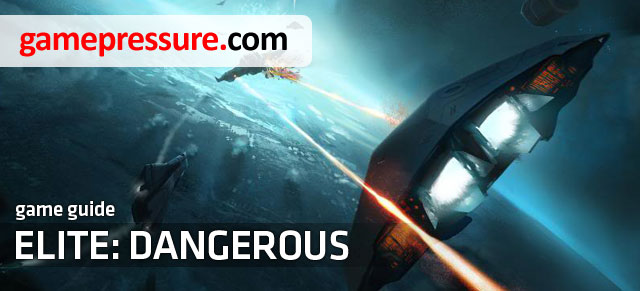

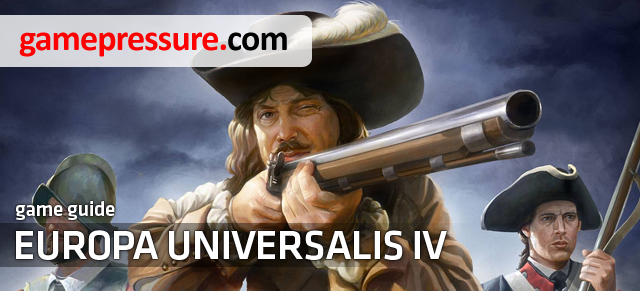
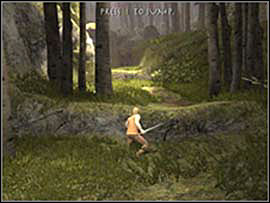
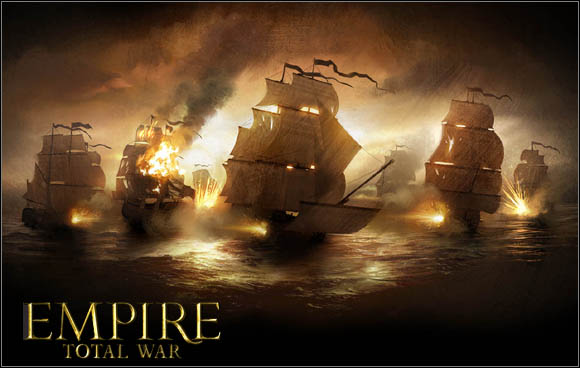 Empire: Total War Game Guide & Walkthrough
Empire: Total War Game Guide & Walkthrough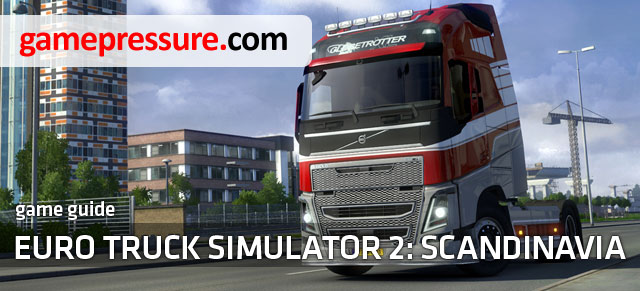 Euro Truck Simulator 2: Scandinavian Expansion Game Guide & Walkthrough
Euro Truck Simulator 2: Scandinavian Expansion Game Guide & Walkthrough Eragon Game Guide & Walkthrough
Eragon Game Guide & Walkthrough Endless Space Game Guide & Walkthrough
Endless Space Game Guide & Walkthrough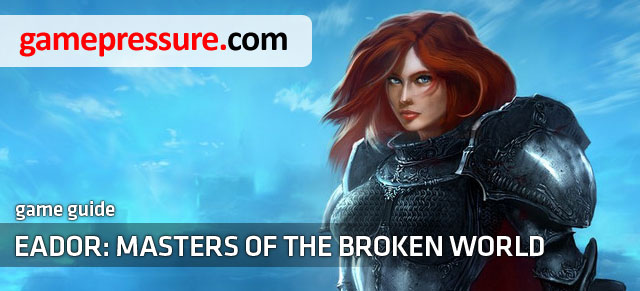 Eador: Masters of the Broken World Game Guide & Walkthrough
Eador: Masters of the Broken World Game Guide & Walkthrough